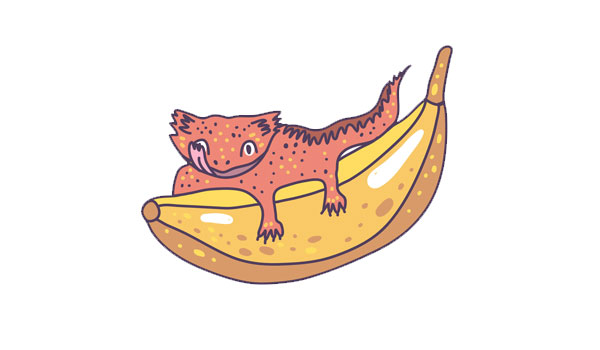
Crested geckos are one of the most popular reptile pet a hobbyist and an animal lover can own at the moment. They are unique and beloved for their mesmerizing scaly body.

As these animals get more and more recognized, they will be sought after. And most people need to know the bare basic information for it, before owning it. The ability for it to live in certain environments, what might it be able to eat, and what not to do in its presence? Among many other questions.
But one very useful piece of information someone might want to ask is, what fruit can Crested geckos eat?
Geckos often eat eggs and smaller insects, but little known about their herbivorous diet. As insects might not always be available on hand and they need a more robust diet to be healthier.
Let’s educate ourselves in this article about the dietary constraints of Geckos with fruits.
What are Crested Geckos?
Crested Geckos, also known as (Correlophus Ciliatus) are an endemic species of Geckos that come from the Isle of Pines and the island of Grand Terre from the New Caledonia archipelago.
They live close to the peaks of mountains and preferably around 150 to 1000 meters above sea level. Similar to the rainforest, the weather is humid and hotter weather of 22°-23°C. They lay on resting on the sunny days on the forest floor, which is much more cooler.
The most fascinating fact about the Crested Geckos is that when it does go out scavenging at night, it does not go higher than 3 meters which are called the (undergrowth or forest floor). This is a very important indicator of its natural dietary ability.
Understanding Crested Geckos diet
Any insect that lives below the understorey, which is the level of the forest above 5 meters of the ground is on the menu. Our main concern is this 5 meters that Geckos choose to traverse in (undergrowth). There are also many types of native fruits and herbs found in the undergrowth that Geckos seek while scavenging for food.
This makes things much easier for us to find out about the fruits they might prefer eating. This is because most undergrowth of rainforests has a similar environment, that can facilitate the growth of fruits of the same species all over the world and with slight variations in their genes.
Meaning you don’t need to seek the native fruits of New Caledonia, and ship them in an expensive procedure to keep the Gecko well-fed in non processed foods.
Very interestingly, any insect species in the undergrowth around such fruits might have a similar body structure and minerals that are found in the species of insects that Crested Geckos consume natively.
But these are few educated conjectures by me and need further research by proper biologists to rely on. Non the less, there is some grain of truth to this theory.
Fruits native to New Caledonia
Fruits that exist in New Caledonia are a potential meal for any Crested Gecko. The most common are bananas, passion fruit, mangoes, avocados, pineapples, watermelons, custard apples, oranges, coconuts, pawpaws, pomelos, etc.
With this abundance of fruits available in the forests, it becomes quite easy for geckos to feast on fruits when available, not to mention they can eat the insects that reside in the fruits.
About 7.52 percent of their diet consists of fruit juices. Meaning that these animals don’t necessarily need to eat fruit, but when given the chance they will gorge on them.
It’s not that surprising that they barely eat fruits on the daily basis. This is because many wild fruits are hard to reach and are often guarded by predator animals and birls much larger than the Crested geckos.
Crested Geckos also have another issue, many fruits don’t usually occupy the undergrowth. More often bat and smaller fruit consuming birds will pick on the fruits leading them to fall. This can help animals on the ground have the ability to feed on these fruits.
Fruit chemical structures
Crested geckos need to have certain amounts of calcium and phosphorus in the fruits to be able to consume them. There are many benefits to these two chemical elements in the body of most animals, especially these lizards. So much so, there is a golden ratio that a Crested gecko must have to stay healthy.
The calcium: phosphorus ratio is very important. You need to learn which fruits have the proper range of calcium and phosphorus before feeding the Crested Geckos.
The benefits of calcium on Crested geckos start from developing the skeletal system into a more solid structure. The females need the calcium to develop the egg cells before it forms full eggs.
Calcium and Phosphorus golden ratio
Phosphorus balances against calcium to work against it. This is due to the body needing some contingency plan when levels of calcium or phosphorus increase. If calcium levels increase in the Crested Gecko’s body, phosphorus decreases and vice versa.
And a very important factor is the golden ratio. In optimal cases, the ratio of calcium to phosphorus should be 2:1. Therefore if there is 2 mg of calcium in the Gecko’s body, phosphorus needs to be about 1 mg to offset the balance.
Which fruits benefit the Geckos the most?
And the level of ratio of calcium to phosphorus in fruits becomes quite important when choosing a proper fruit for it to be fed. Also, the fruit flesh or skin needs to be soft enough for these creatures to consume without needing much work or harming their fragile mouths.
Most fruits in general don’t have high levels of calcium, to begin with, and have larger stores of phosphorus in a 1:2 ratio. So this inverses the ratio, but they can be fed twice the amount of fruit to keep more reserve of calcium and the Gecko can excrete the excess phosphorus later on.
Fruits like plums, cantaloupes, bananas, pomegranates, plums, passion fruits, and pumpkins.
This is, unfortunately, an improper way to handle the feeding of Geckos. These fruits are to be fed only if the gecko has no other fruit to be fed or no food at all.
They are not harmful by any means, but you need to be optimal about the feeding habits of your gecko and not overfeed it to somewhat balance the ratios of calcium.
The second type of fruit has simple calcium and phosphorus ratios. They often have a 1:1 ratio and are quite ok to have the geckos feeding on them.
Apples, pears, melons, cherries, and berries are some of the fruits you can feed your geckos without any sort of negative effects.
The third and most effective type of fruit for your geckos has a very high concentration of calcium and a low ratio of phosphorus. These fruits usually have a great ratio of 2:1 ratio.
Prickly pear, raspberries, figs, and papayas have the highest concentration of calcium. These are very beneficial if the geckos consume in moderation.
Fruits to avoid for Crested geckos
There are many fruits that Geckos can’t and shouldn’t eat. These contain a chemical that is quite harmful. Citric and oxalic acid are the most harmful and to watch out for. Lemons, oranges, and other fruits with high levels of citric and oxalic acids are to be avoided.
Avocados also have a slight bit of toxin called persin, which is lethal in large doses for pets. And reptile-like pets which are small in size have horrible symptoms because of avocados.
Ways to feed fruits to Crested Geckos
Crested geckos have very small and fragile teeth. They need the fruits to have very smooth and soft flesh. As such, the need to mash and making a puree out of it is warranted.
The amount of fruits fed is also up to the animal. Usually a tiny bit at a time or more depending on its appetite. Unlike dogs, lizards like these are wilder in nature and know when to stop eating. They won’t get obese very fast if you moderately feed them.
But as always their major food source is incests like locusts and other small creatures. Fruits are their second most consumed food after insects. So giving them fruits as treats is a very smart way to go about it.
To Conclude
Crested geckos are beautiful animals, that need vigilance and care. Fruits are also special treats that need to be in their diets, to give them a natural range of minerals.



